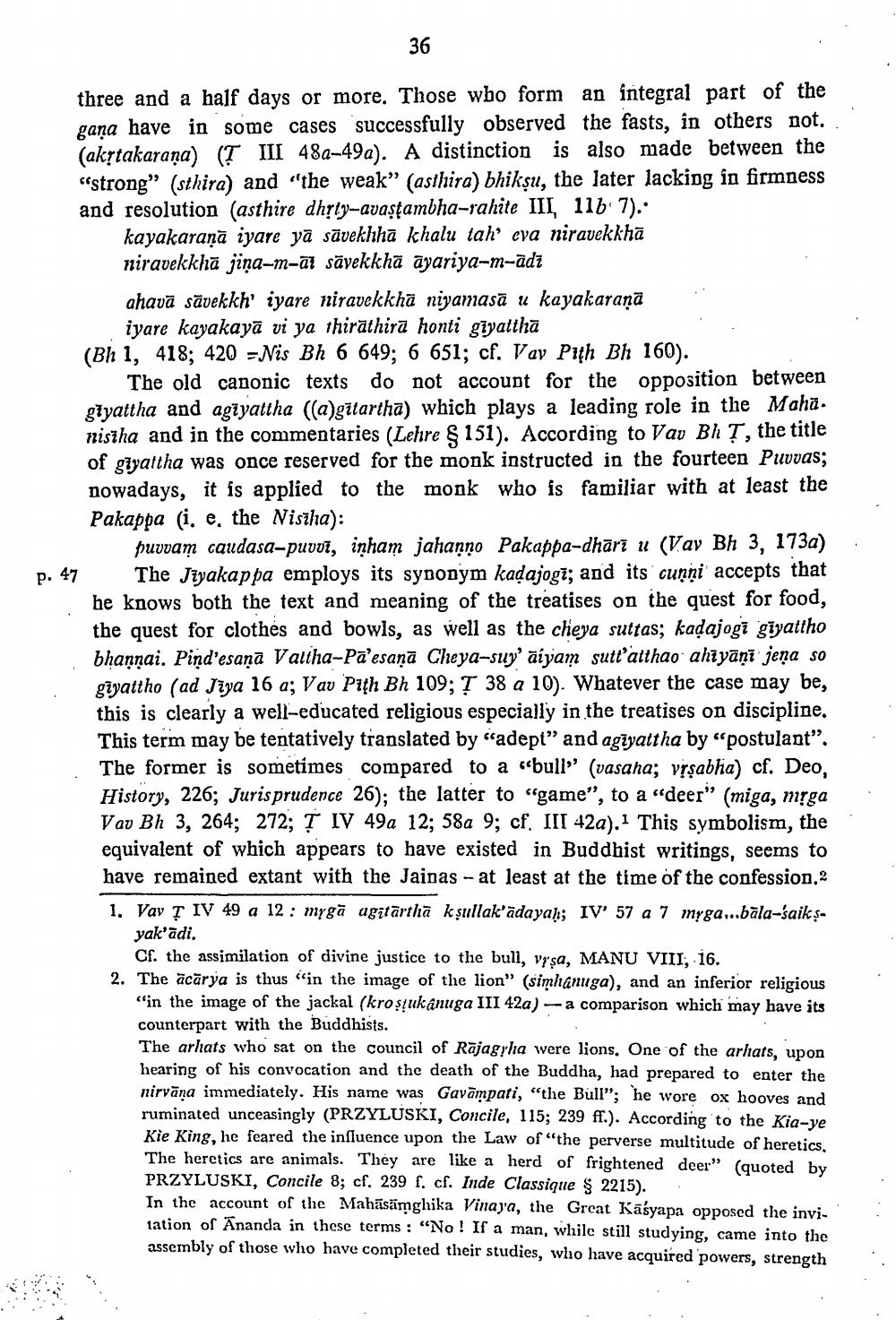________________
36
three and a half days or more. Those who form an integral part of the gana have in some cases successfully observed the fasts, în others not. (akṛtakarana) (T III 48a-49a). A distinction is also made between the "strong" (sthira) and "the weak" (asthira) bhikṣu, the later lacking in firmness and resolution (asthire dhṛty-avaştambha-rahite III 11b 7).
kayakarana iyare ya sävekhha khalu tah' eva niravekkhā niravekkhā jiņa-m-āt sāvekkhā āyariya-m-ādī
ahavā savekkh' iyare niravekkha niyamasā u kayakaraṇā iyare kayakaya vi ya thirathira honti giyattha
(Bh 1, 418; 420 Nis Bh 6 649; 6 651; cf. Vav Pith Bh 160).
The old canonic texts do not account for the opposition between giyattha and agiyattha ((a)gitartha) which plays a leading role in the Maha. nistha and in the commentaries (Lehre § 151). According to Vav Bh Ţ, the title of giyattha was once reserved for the monk instructed in the fourteen Puvvas; nowadays, it is applied to the monk who is familiar with at least the Pakappa (i. e. the Nistha):
p. 47
puvvam caudasa-puvvt, inham jahanno Pakappa-dhari u (Vav Bh 3, 173a) The Jiyakappa employs its synonym kaḍajogi; and its cunni accepts that he knows both the text and meaning of the treatises on the quest for food, the quest for clothes and bowls, as well as the cheya suttas; kaḍajogi giyattho bhannai. Pind'esana Valiha-Pa'esana Cheya-suy' aiyam sutt'atthao ahiyāni jena so giyattho (ad Jiya 16 a; Vav Pith Bh 109; T 38 a 10). Whatever the case may be, this is clearly a well-educated religious especially in the treatises on discipline. This term may be tentatively translated by "adept" and agiyattha by "postulant". The former is sometimes compared to a "bull" (vasaha; vṛṣabha) cf. Deo, History, 226; Jurisprudence 26); the latter to "game", to a "deer" (miga, mṛga Vav Bh 3, 264; 272; T IV 49a 12; 58a 9; cf. III 42a).1 This symbolism, the equivalent of which appears to have existed in Buddhist writings, seems to have remained extant with the Jainas - at least at the time of the confession.2 1. Vav T IV 49 a 12 myga agitartha kṣullak'adayaḥ; IV' 57 a 7 myga...bala-saiksyak'adi.
Cf. the assimilation of divine justice to the bull, vrsa, MANU VIII, 16.
2. The acarya is thus "in the image of the lion" (simhanuga), and an inferior religious "in the image of the jackal (kro ṣṭukânuga III 42a)-a comparison which may have its counterpart with the Buddhists.
The arhats who sat on the council of Rajagṛha were lions. One of the arhats, upon hearing of his convocation and the death of the Buddha, had prepared to enter the nirvana immediately. His name was Gavampati, "the Bull"; he wore ox hooves and ruminated unceasingly (PRZYLUSKI, Concile, 115; 239 ff.). According to the Kia-ye Kie King, he feared the influence upon the Law of "the perverse multitude of heretics. The heretics are animals. They are like a herd of frightened deer" (quoted by PRZYLUSKI, Concile 8; cf. 239 f. cf. Inde Classique § 2215).
In the account of the Mahasamghika Vinaya, the Great Kasyapa opposed the invitation of Ananda in these terms: "No! If a man, while still studying, came into the assembly of those who have completed their studies, who have acquired powers, strength




